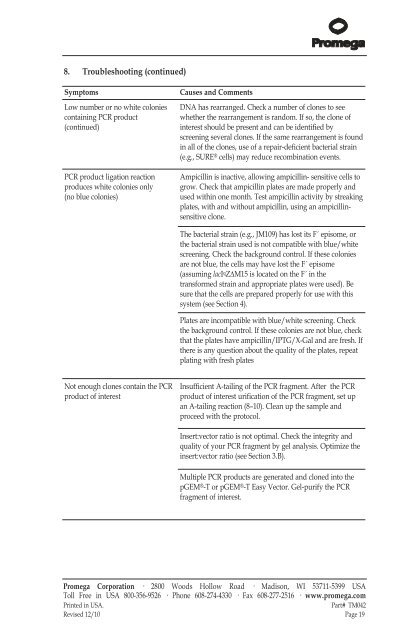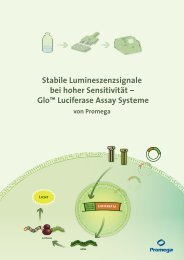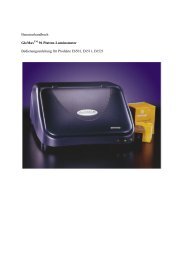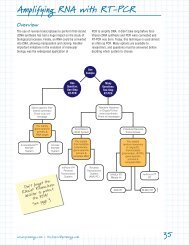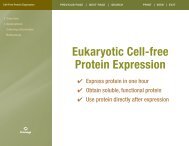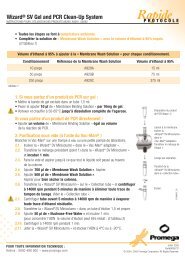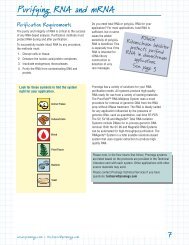pGEM-T and pGEM-T Easy Vector Systems Technical ... - Promega
pGEM-T and pGEM-T Easy Vector Systems Technical ... - Promega
pGEM-T and pGEM-T Easy Vector Systems Technical ... - Promega
Create successful ePaper yourself
Turn your PDF publications into a flip-book with our unique Google optimized e-Paper software.
8. Troubleshooting (continued)<br />
Symptoms Causes <strong>and</strong> Comments<br />
Low number or no white colonies<br />
containing PCR product<br />
(continued)<br />
PCR product ligation reaction<br />
produces white colonies only<br />
(no blue colonies)<br />
Not enough clones contain the PCR<br />
product of interest<br />
DNA has rearranged. Check a number of clones to see<br />
whether the rearrangement is r<strong>and</strong>om. If so, the clone of<br />
interest should be present <strong>and</strong> can be identified by<br />
screening several clones. If the same rearrangement is found<br />
in all of the clones, use of a repair-deficient bacterial strain<br />
(e.g., SURE ® cells) may reduce recombination events.<br />
Ampicillin is inactive, allowing ampicillin- sensitive cells to<br />
grow. Check that ampicillin plates are made properly <strong>and</strong><br />
used within one month. Test ampicillin activity by streaking<br />
plates, with <strong>and</strong> without ampicillin, using an ampicillinsensitive<br />
clone.<br />
The bacterial strain (e.g., JM109) has lost its F´ episome, or<br />
the bacterial strain used is not compatible with blue/white<br />
screening. Check the background control. If these colonies<br />
are not blue, the cells may have lost the F´ episome<br />
(assuming lacI qZΔM15 is located on the F´ in the<br />
transformed strain <strong>and</strong> appropriate plates were used). Be<br />
sure that the cells are prepared properly for use with this<br />
system (see Section 4).<br />
Plates are incompatible with blue/white screening. Check<br />
the background control. If these colonies are not blue, check<br />
that the plates have ampicillin/IPTG/X-Gal <strong>and</strong> are fresh. If<br />
there is any question about the quality of the plates, repeat<br />
plating with fresh plates<br />
Insufficient A-tailing of the PCR fragment. After the PCR<br />
product of interest urification of the PCR fragment, set up<br />
an A-tailing reaction (8–10). Clean up the sample <strong>and</strong><br />
proceed with the protocol.<br />
Insert:vector ratio is not optimal. Check the integrity <strong>and</strong><br />
quality of your PCR fragment by gel analysis. Optimize the<br />
insert:vector ratio (see Section 3.B).<br />
Multiple PCR products are generated <strong>and</strong> cloned into the<br />
<strong>pGEM</strong> ® -T or <strong>pGEM</strong> ® -T <strong>Easy</strong> <strong>Vector</strong>. Gel-purify the PCR<br />
fragment of interest.<br />
<strong>Promega</strong> Corporation · 2800 Woods Hollow Road · Madison, WI 53711-5399 USA<br />
Toll Free in USA 800-356-9526 · Phone 608-274-4330 · Fax 608-277-2516 · www.promega.com<br />
Printed in USA. Part# TM042<br />
Revised 12/10 Page 19


